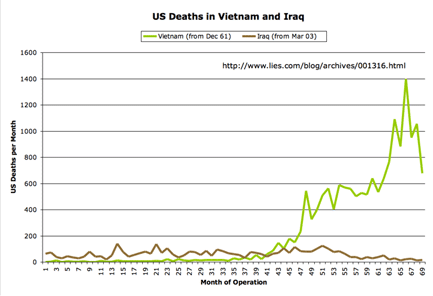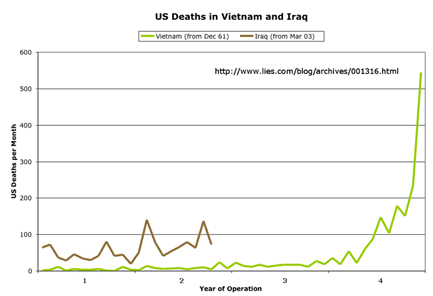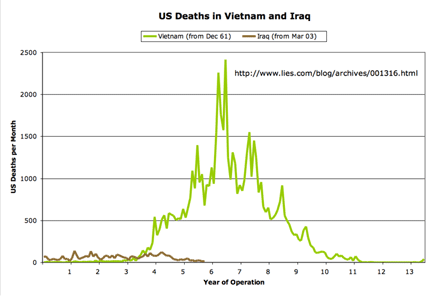November: The Cruelest Month
More US troops died in Iraq in November than during any previous month of the war, including “major combat operations” last spring. With US military leaders reviving the inflated enemy bodycount as a way of putting a positive spin on things, it seemed like a good time to update my charts comparing US deaths in Iraq and Vietnam (see my earlier postings here and here). Again, I’m getting these figures from the advanced search tool at the Vietnam Veterans Memorial Fund site, and from Lunaville’s page on Iraq coalition casualties. The figures are for the number of US dead per month, without regard to whether the deaths were combat-related.
The first graph shows the first twelve months of the Vietnam war, and the first nine months of the Iraq war. (Click on any image for a larger version.)
Next, the same chart, with the Vietnam numbers extended out to cover the first four years of the war:
Finally, the chart that gives the US death toll for the entire Vietnam war:
These charts really seem to annoy supporters of the war who think I’m trying to make an argument that Iraq is “worse” than Vietnam because the brown line on the charts is higher than the corresponding portion of the green line. Even among the not-so-annoyed, it’s a common observation that these numbers haven’t been normalized for the number of troops in-theater, so any comparison that tries to derive a sense of the relative lethality of the two wars from these charts willl be way off-base. More than one observer has suggested that a more valid starting point for the Vietnam numbers would be somewhere around March of 1965 (year 3.3 or so on the last two graphs above), since that’s approximately when the number of US troops on the ground in Vietnam matched the number currently in Iraq, and when US forces in Vietnam really began engaging in direct combat operations, rather than the training/advisory role they were playing prior to that.
Others have questioned my focus on US military deaths. What about the other side’s death toll? What about all the young men and women whose lives have been shattered by horrific injuries? And what about the many thousands of non-combatant Iraqis who have been killed in the fighting?
All these folks have valid points. It really would be stupid for me to try to argue from these numbers that Iraq is somehow “worse” than Vietnam, that one conflict is more or less dangerous than the other for a typical soldier, or that December of 1961 is an appropriate point to begin counting Vietnam war deaths in order to derive some kind of lesson about military strategy or tactics. It would likewise be wrong for me to argue that US military fatalities are the only, or the most significant, cost of this war.
But I’m not arguing any of those things.
Again, as I’ve said from the beginning, I’m looking at something fairly specific here. I’m looking at the history of each of these conflicts not in terms of the military situation, but in terms of domestic US politics. I’m interested in US attitudes about the war, and politicians’ statements about the war, at similar points in each conflict’s political timeline. Given that, I think it’s valid to start the Vietnam numbers at the point when President Johnson first started talking about US soldiers dying in the cause of Vietnamese freedom. And since the count of US dead is one of the most direct, unambiguous pieces of data about the cost of these wars, at least in the eyes of the domestic audience, I think a comparison of the US military death toll at similar points in each war’s history makes for an interesting, if depressing, graph.
Those who want to use the numbers to make other sorts of arguments are welcome to do so. (You can download a CSV version of my data to help you, if you wish.) I haven’t been able to find month-by-month statistics for troop levels in Vietnam, but the year-end numbers I have found seem to generally support the view that both conflicts are pretty close to each other in terms of lethality per 1,000 troops.




June 1st, 2004 at 1:55 pm
[…] new numbers become available. US deaths in Vietnam and Iraq by month Iraq war deaths November: The cruelest month 41 US Iraq war dead in December Post-Saddam death t […]
August 2nd, 2004 at 2:00 pm
[…] new numbers become available. US deaths in Vietnam and Iraq by month Iraq war deaths November: The cruelest month 41 US Iraq war dead in December Post-Saddam death t […]
September 3rd, 2004 at 2:16 pm
[…] new numbers become available. US deaths in Vietnam and Iraq by month Iraq war deaths November: The cruelest month 41 US Iraq war dead in December Post-Saddam death t […]
November 1st, 2004 at 4:10 pm
[…] new numbers become available. US deaths in Vietnam and Iraq by month Iraq war deaths November: The cruelest month 41 US Iraq war dead in December Post-Saddam death t […]
December 2nd, 2003 at 1:42 pm
I’ve been looking at the graph shape, personally. When are the peaks, when are the dips. I think that by war-end, they’ll probably be pretty similar.
Keep in mind that to do this I’m using a “percentage of time spent in theatre of operations” as opposed to any static numbers regarding the time the troops ave spent in their respective wars. As it currently stands by my numbers, a few months in Iraq are equaling a few years in Vietnam.
Unlike jbc, however, I’m not motivated enough to make a pretty chart :D
January 7th, 2004 at 2:49 pm
I don’t see any value in this graph comparison, other than to see what you want to see. At best it’s like comparing apples to oranges, at worst it’s “voodoo statistics” used to spin a particular point of view.
Vietnam and Iraq are entirely different situations, and for that reason alone there is no predictive value to laying one graph on top of the other. For example:
– In Vietnam, the insurgents enjoyed widespread support from the general population. In Iraq, polls show that the overwhelming majority of the population is against the insurgency (even if they are not pro-coalition).
– In Vietnam, the insurgency was constantly being massively resupplied by outside powers. In Iraq, the insurgents depend mostly on previously stored supplies and money, the quantities of which are being depleted (or captured) daily.
The list of differences (terrain, technology, rules of engagement, political will, etc.) goes on and on.
People made comparisons like this when we went into Afghanistan. Everyone dragged out statistics from the Soviet invasion and we all heard about the “meat grinder” we were getting sucked into. Even though we were fighting a war in the same country against some of the same people, the outcome was radically different.
April 9th, 2004 at 2:09 pm
Perhaps Roger might wish to reconsider his opinion of the Afghan annexation in view of the rapidly escalating death rate of US troops stationed there today?
July 30th, 2004 at 3:41 am
The first Vietnam combat death was in 1957. You’re starting late.
September 12th, 2004 at 9:56 pm
It’s now September 2004 and the trend continues. Whatever the interpretation of the raw data, it is obvious that Iraq is at a very early stage (unless we pull off a miracle, then pull out); note that Vietnam had a momentum that reached a peak after about 7-8 years. We risk losing comparable numbers in Iraq only if we send comparable numbers over there—difficult to do absent a draft.
If I may quote from someone much wiser : There is no way to peace; peace IS the way. When will we realize this?
November 21st, 2004 at 12:18 pm
The context of the two wars were different, as Roger pointed out. But in terms of pure casualty lists, one can see that Iraq is the worse of the two. As in Vietnam, we do not have the support of the general population, which should be a pre-requsite to regime change.
November 21st, 2004 at 12:34 pm
I think you’re not looking at the larger picture, Alex. In the course of the Vietnam war the US suffered something like 58,000 combat fatalities. So far in Iraq we’re at about 1,200. Maybe you mean something else when you say “in terms of pure casualty lists,” but to me, that sounds like Vietnam, at least at this point, is the worse of the two.
It’s potentially misleading, as many people have pointed out, the way I’ve started each war’s timeline in the graphs above at a pont when we had a major troop presence in Iraq, but only a minimal advisory role in Vietnam. I think you’re letting yourself be misled by that.
December 8th, 2004 at 3:23 pm
Has anyone counted the wounded ratio comparing both vietnam and Irak?